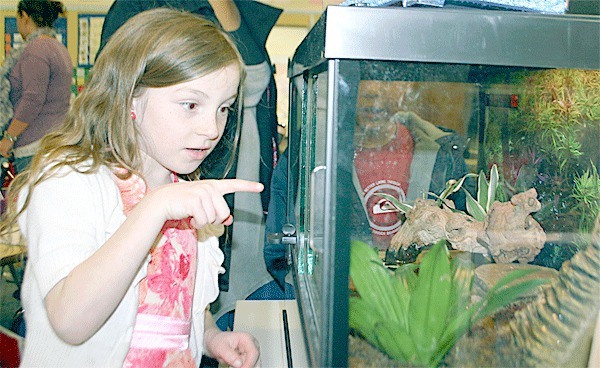First-grade students at Olympic View Elementary School pulled their parents along by one hand last Wednesday, and used the other hand to point out fire-bellied newts, fire-bellied frogs and a leopard gecko in their own classroom.
Even better than showing their parents and siblings their latest school project is that they get to take part of it home. Brian Knoll, owner of Island Pet Center, made mini aquariums for each of the students and they will bring home their own pet fish.
“When we were talking about fish today, a couple said really excitedly, ‘My first pet!’ and I think that’s really cool,” said Janet Sodano, first-grade teacher.
Sodano applied for a $1,500 grant from the Oak Harbor Education Foundation to fund this habitat project, a hands-on approach to teaching the state standards of science. All three first grade classes joined in, totaling nearly 75 students.
“Every penny of it is going to Island Pet Center, so we’re doing our part supporting the local economy,” Sodano said.
Knoll built three unique habitats and supplied the corresponding critters, which rotated between the three classrooms over seven weeks. Knoll will bring them back year after year so each class can benefit.
The purpose of the project is to teach students why different animals need to live in different habitats, and also to educate children about having pets.
But the learning doesn’t stop there. As the students take home their new pet fish, they are required to keep a journal about what the fish does, a task especially important as spring break approaches.
“It’s something really hands-on,” Sodano said, adding that it’s a way to integrate science and writing.
“I think it’s important for them to learn education isn’t just something that happens out of a book,” Sodano added.
Another important aspect was that parents and siblings were invited into the classroom to learn about the students’ project.
“We try to have regular things to do where parents can come in and see their kids in their natural habitat, so to speak,” Sodano said.
“For the community to be involved, for local businesses to help do this for the students — I’m excited,” said Erica Wasinger, a member of the Oak Harbor Education Foundation. “I can’t think of a better way to apply the state standards they need to learn for science. It’s awesome.”
“The kids are excited,” Wasinger added, which was obvious from the enthusiastic chatter and the crowd of faces around the animal tanks.
Student Natalia Aguilar said she’s looking forward to caring for her new fish. She was also happy to show her mom the book each student wrote and illustrated, entitled “A Place to Call Home.”
Student Lindsey Latta’s favorite creature was the leopard gecko.
“We learned leopard geckos are nocturnal,” Latta said. They also learned geckos eat crickets, to which Latta responded: “It’s gross.”
Knoll came to the family open house, and he’d also spoken with the classes earlier about the animals.
“It was a lot of fun. It was a good opportunity to get involved with these kids that are so enthusiastic,” Knoll said.
Knoll has worked with Oak Harbor Elementary School for six years on their salmon project, which allows students to watch salmon eggs hatch in a tank in their classroom. He said this first-grade project was much more ambitious but very worth it, especially upon seeing the enthusiasm of the students.
“I think it’s wonderful the teachers go above and beyond to do this,” Knoll said, adding that he knows it’s difficult for teachers to find the time to do so, but if the project encourages one student to have an interest in science that they didn’t have before, then the project has more than succeeded.
“It’s very important for me to be involved in the community,” Knoll said, adding that he has four children in the school system. “Business people in this community working together: that’s the beauty of a small community. If everyone in the community could have the chance to come stand back and watch something like this, how would you not want to be involved in that,” Knoll said.



